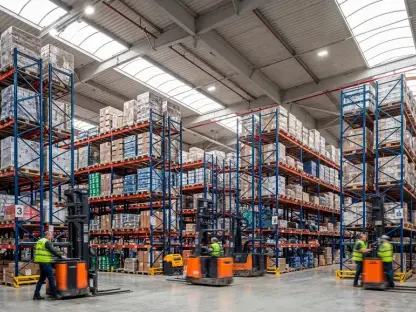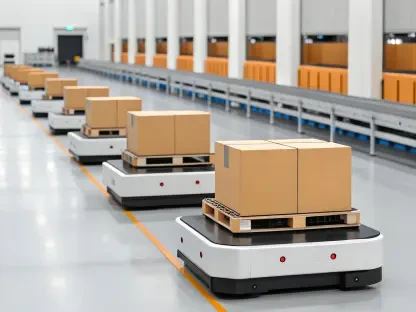Setting the Stage for Affordable Automation Growth
In an era where operational efficiency dictates market success, warehouse automation has emerged as a pivotal force, with global investments projected to skyrocket to $59 billion by 2030 from a current base of $19 billion. This staggering growth underscores a critical shift: automation is no longer an exclusive domain of corporate giants but a viable strategy for businesses of all sizes in industries like retail, manufacturing, healthcare, and logistics. The challenge lies in navigating the financial barriers that once made such technologies seem out of reach. This market analysis delves into the trends, data, and projections surrounding cost-effective warehouse automation, exploring how modular systems, innovative financing, and scalable solutions are reshaping the landscape. By examining current patterns and future trajectories, the goal is to equip stakeholders with insights to capitalize on this transformative wave.
Diving Deep into Market Trends and Projections
The Democratization of Automation Technology
The warehouse automation market is witnessing a profound transformation as technological advancements and economic pressures converge to make solutions more accessible. Historically, high upfront costs and complex infrastructure requirements limited adoption to large enterprises with substantial budgets. However, recent shifts toward modular and flexible systems have lowered entry barriers, enabling small and medium-sized businesses to participate. Data indicates a robust compound annual growth rate in automation investments, driven by the urgent need to address labor shortages and rising operational expenses. Retailers and logistics firms, in particular, are leveraging these tools to meet surging e-commerce demands, highlighting a market trend where affordability aligns with necessity.
Key Drivers Fueling Adoption Across Sectors
Labor market challenges stand out as a primary catalyst propelling the automation surge. With workforce shortages impacting order fulfillment and driving up costs, companies across sectors are turning to automation to maintain competitiveness. For instance, regional distributors unable to meet daily shipment quotas due to insufficient manpower are losing ground to rivals, pushing the adoption of cost-effective tools as a survival mechanism. Economic factors, such as fluctuating wage rates, further amplify this trend, while regulatory pressures around workplace safety add another layer of motivation. Projections suggest that over the next five years, from 2025 to 2030, the market will see accelerated growth as businesses prioritize solutions that balance efficiency with financial prudence.
Spotlight on Affordable Tools and Technologies
Drilling down into specific innovations, autonomous mobile robots (AMRs) for pallet transport have emerged as a cornerstone of cost-effective automation. These systems offer minimal disruption to existing operations, working alongside human staff to boost productivity with relatively low initial investment. Beyond AMRs, robotic picking systems are gaining traction, with advancements reducing costs and enhancing capabilities for intricate tasks like unit picking. Non-robotic options, such as lift-assist devices, also play a vital role by improving worker safety during repetitive activities. Market analysis reveals that these tools, alongside automated guided vehicles (AGVs) for consistent pallet handling, are driving a shift toward incremental upgrades rather than full-scale overhauls, catering to diverse business needs.
Modular Systems and Financing as Game Changers
A defining trend in the current market is the rise of modular automation systems paired with innovative financing models. These approaches allow businesses to start small with high-impact solutions and scale up as resources permit, mitigating the risk of overcommitment. Flexible payment structures eliminate the need for massive capital expenditures, making automation feasible for smaller players. Industry reports highlight that companies adopting this phased strategy report quicker returns on investment due to reduced labor expenses and improved order accuracy. Looking ahead, the market is expected to see an influx of customizable solutions tailored to fluctuating demands, ensuring long-term adaptability without locking firms into rigid frameworks.
Regional and Sectoral Variations in Adoption Rates
Geographical and industry-specific factors significantly influence the pace and nature of automation adoption. In regions with high labor costs, such as parts of North America and Western Europe, businesses are more inclined to invest in AMRs and AGVs to offset expenses. Conversely, in areas with lower infrastructure readiness, simpler tools like mobile put walls for seasonal order consolidation are gaining popularity due to their ease of integration. Sectoral differences also emerge, with healthcare warehouses prioritizing precision-focused automation for inventory management, while manufacturing hubs lean toward robust systems for heavy-duty tasks. This segmentation suggests a market trajectory where tailored solutions will continue to dominate, addressing unique operational pain points.
Future Outlook: Emerging Innovations and Challenges
Peering into the horizon, the warehouse automation market is poised for further evolution with artificial intelligence and advanced sensor technologies set to enhance system precision and affordability. Predictions indicate that by 2030, the integration of AI-driven analytics will optimize workflows, reducing errors and costs even further. However, potential challenges loom, including the risk of mismatched systems or underutilized investments if strategic planning is overlooked. Economic uncertainties and supply chain disruptions could also impact adoption timelines. Despite these hurdles, the trend toward scalable, modular systems is expected to persist, with smaller warehouses likely to mirror the automation levels of large distribution centers within the next decade.
Reflecting on Insights and Charting the Path Forward
Looking back on this analysis, it becomes evident that the warehouse automation market has undergone a remarkable shift, breaking down financial barriers and enabling businesses of all sizes to harness transformative technologies. The exploration of trends revealed how labor shortages, economic pressures, and modular innovations have collectively fueled a surge in adoption across diverse sectors and regions. Projections underscored a future where affordability and adaptability remain central, with emerging tools promising to redefine operational norms. For stakeholders, the next steps involve assessing immediate operational gaps and prioritizing low-risk, high-impact solutions like AMRs as entry points. Partnering with providers offering scalable systems and flexible financing has proven crucial, as has the commitment to regularly evaluate performance metrics to ensure sustained growth. By staying agile and open to incremental advancements, businesses position themselves to navigate market challenges and seize opportunities in an increasingly automated landscape.









